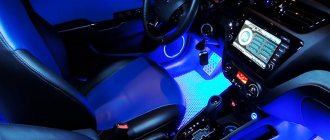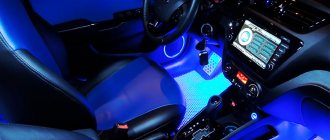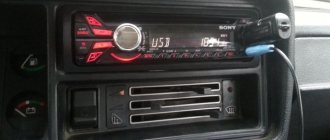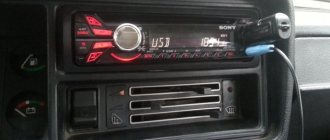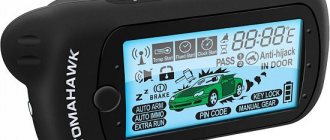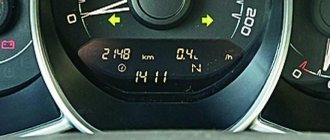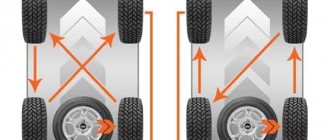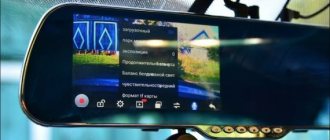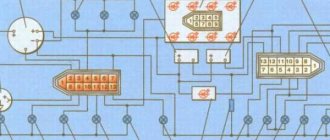Tuning and auto gadgets / From Sergey Vasilenkov
- How to choose the right radar detector for your car: selection criteria, types, characteristics
Supported frequency ranges - Sensitivity and selectivity
- Information display method
- Availability of GPS
- Possibility of software update
- Additional features
Over the past few years, Russia has seen a rapid increase in fines for violations of traffic rules (traffic rules), in particular for violating the speed limit. Nowadays, the fine for speed driving varies from 500 to 5,000 rubles, so it is not surprising that many car owners are thinking about buying a radar detector (not to be confused with a radar detector). At first glance, it seems that buying a radar detector is easy, but when you go, for example, to Yandex.Market, car owners are faced with more than six hundred different models, each of which differs not only in the name of the manufacturer and price, but also in technical characteristics. How to choose the right radar detector or antiradar for a car?
Choosing the right location to install the radar detector
stop-radar.com
Experienced
You bought a radar detector and now want to start using it.
Don't make the most common mistake of simply placing it on your dashboard before you hit the road. If you use this device without knowing exactly how it works and what information it conveys, it may not serve you well. First installation rule
states: The radar detector must be mounted in a place where the road ahead is clearly visible. It should always be in your field of vision, but you should not be distracted from control. You need to be able to put the radar detector somewhere, for example, to hide it from thieves, but what if the contacts accidentally become disconnected and the detector turns off without you noticing? Think about how much risk you expose yourself to every time you take your eyes off the road and peer into the radar detector screen.
In most cases, the radar is hung next to the rearview mirror. Actually, this is not a bad idea. After all, television and radio transmitters are installed on high towers so that the signal spreads as far as possible. A long radio antenna on a traffic police car, for example, also contributes to good radio signal reception. Yes, but police radar is fundamentally different from all the equipment with which our favorite radio stations broadcast.
A distinctive feature of radio equipment is that it transmits a signal at 360 degrees. But the radar beam goes straight, it is very narrow, only 3-9 degrees, if we are talking about certain models of K-band radars. And this directed concentrated beam scatters at a distance, bouncing off any metal surfaces that come in its way. In all the time I've been testing radar detectors, I've never seen a single radar whose range is truly significant.
would increase when moving the device from the passenger side of the dashboard to the upper area of the windshield.
There is another disadvantage when installing the detector at a height: it begins to produce serious errors when detecting a laser beam. Always remember one fact. A laser beam can be detected by a detector from a distance of 60 m if the detection zone of the detector is a circle with a diameter of about 1 m. The beam is so dense, so thin that if it is aimed at a front license plate (a favorite target of police officers), many detectors are simply not able to detect it. Remember: the larger the vehicle, the further away the radar detector will be from the metal plate of the license plate, and the less efficient it will be at detecting the laser beam.
Raise it even higher, and the increased distance to the front registration number will confuse even the best radar detectors. Carefully study the results of the radar test, paying special attention to such a parameter as the radar field of effect. Of fundamental importance is the ability of the device to respond already at the edge of the laser beam. If the detector's field of action, for example, is, on average, about 70 cm, then in the vast majority of cases (unless you are riding a skateboard, of course), the laser beam cannot be detected until it is aimed directly at the head. " Such detectors can have a good maximum detection range, but at an even greater range the laser beam is scattered even more. The spread may be more than 6 meters. However, at a distance of 300 m or less, the narrow beam will hit the target without even disturbing the detector.
What if you install the detector on the windshield, somewhere in the middle? This is an acceptable option, but it also has disadvantages. First of all, you advertise the fact that you have a radar detector. And many traffic police inspectors can’t stand them. And in those countries where it is prohibited, they have instruments and methods in their arsenal that they can use to determine the presence of a working device in a car.
Here is one of them, time-tested, allowing you to easily detect someone who uses the detector in the dark. The police follow the speeding violator and then turn on their radar. Even if the driver is smart enough to not slam on the brakes immediately after the warning signal from his radar detector, a police officer may notice his warning lights displayed on the screen of the device inside the car. (If the detector has a very large screen, it can be seen from several tens of meters behind the car).
Another thing that indicates that you have a radar detector is the behavior of other drivers. If you are driving at speeds above 130-140 km/h, some drivers who do not have a radar detector will notice that you have one and will tail you. You will pave the way for them. It gets on your nerves and is dangerous. If you suddenly brake after receiving a signal from the detector, the likelihood that the idiot driving behind will hit you in the rear bumper increases dramatically. My advice: mount the radar as low as possible on the windshield or place it on the dashboard.
In this position, it will function well and will not be so noticeable to others.
Remember:
The very small, literally pinpoint width of the laser beam means that the beam can reach the front registration number without hitting the radar detector located high on the windshield of the car. As a result, the radar detector will not issue any warning.
And place it like this
so that you can reach the control buttons. In particular, make sure that you can reach the volume control and operating mode (City/Highway) buttons. The mute button should also be within reach. On models that do not have such a button (and they are quite rare these days), you need to provide quick access to the buttons to turn off sound alerts in case you enter an area where third-party or false signal sources are active. Nothing is more annoying than persistent sound signals emanating from some source of radiation in the roadside area. Or the radar detector starts beeping continuously while you are stuck in a traffic jam.
Don't forget about safety precautions. Since the detector attached to the windshield or rearview mirror is not firmly glued to the surface, it may become loose over time. A device that falls while driving can cause injury to the driver or passenger. Also, during a sudden stop, the passenger runs the risk of hitting the detector located on the windshield. Don't forget this when driving.
How to properly install and configure a radar detector
Road traffic in Russia is a constant confrontation between traffic police officers and motorists. The former control traffic flows on roads, use traffic radars and automatic video recording cameras, and consider fines for traffic violators to be the main way to ensure safety. The latter seek to avoid punishment, deceive control systems and use anti-radars and radar detectors for this.
How effective are the means of combating traffic police radars, how to choose, install, configure and use?
Design features, manufacturers and price
According to design features, it is customary to distinguish:
- Multifunctional devices that combine several devices at once. For example, a video recorder and a radar detector.
- Detectors consisting of several components installed in different parts of the car. Such detectors are installed once and for all, and therefore are not very popular among car owners.
- Monoblock devices are the most popular devices, representing a small block that can be placed either on the glass or dashboard, or behind the interior rearview mirror.
Also, having decided to acquire a radar detector, the driver must decide on the available budget, since depending on the functionality, type, dimensions and material of the case, the price of the device also changes, which can reach $400.
PlayMe has proven itself well in the Russian radar detector market
The best products on the market have proven themselves to be products from PlayMe, Street Storm, Cobra and Whisler, which, although a little more expensive than their main competitors, have the best price/quality ratio. If your budget is limited, you can take a closer look at the products of Karkam, Inspector, ParkCity and Neoline.
Operating principle of a radar detector
Radar detectors are the previous generation of means of combating radars and video cameras on the roads, which are used by State Traffic Inspectorate employees. These are active devices that create frequency interference and prevent police radars from accurately detecting speeding violations. They operate in a wide range of frequencies and disrupt the operation of not only traffic police equipment, but also surrounding frequency devices (including ABS systems and GPS equipment). Therefore, these devices are dangerous and prohibited for use in the Russian Federation.
The most common operating modes of radar detectors
- Instant On. The device is in ready mode.
- ROP. Measures speed in pulses.
- City. Provides the ability to identify devices operating in different frequency ranges.
- Route. The radar detector operates at maximum settings.
Installing a radar detector in a car
The location and position of the radar detector are fundamentally important, since direct visibility and the absence of obstacles significantly improve its accuracy and functionality, and also reduce the number of false alarms.
- If your radar has a monoblock design, it can be installed on the front panel in the cabin - in front of the windshield.
- If the design is combined, then only the radar indicator can be placed on the dashboard, and the receiving module can be hidden under the panel.
The front part of the device should be turned towards the driver, with the receiver facing forward, exactly as the car is moving. It would be optimal to install the device together with the DVR in the middle of the windshield of the car or on the rear view mirror pillar: at its upper edge (then it will be able to receive signals when driving on hilly terrain). Radars usually have their own mounting: brackets with latches, suction cups or Velcro. It is important that when installing a radar detector, the view is not obstructed by the power cord from the cigarette lighter, which will distract attention when moving.
Any obstacles in front should be removed. Including the need to change the athermal glass and metallic tinting on the windshield, which screens the signals (the error rate increases by 10-60%).
However, the correct location of the radar detector in the car interior is only the first stage. Any equipment of this type will only work if it is configured correctly.
Procedure for setting up the radar detector
First of all, it is necessary to update the signature databases (signals from traffic police radar equipment and extraneous frequency “noise”). To do this, you need to download the file with the latest device firmware to your PC, connect the radar detector to it via a USB port, download and run the installer, then download the database from the specified path into the device and update the program.
Next, the radar is configured internally by going to the Menu, where the Menu and Dim buttons are used to switch between settings, and the Mute and City buttons are used to select parameters within each setting. The device is configured in the following sequence:
- language selection (English/Russian);
- selection of an algorithm for processing GPS points (ATO) from the database (entry point into the radar zone and its location point). At the same time, ATO = OFF (ATO = 0) is the starting detection mode, depending on the speed of the car;
- selecting a greeting mode on the display (““, “Hello!”, “Welcome”);
- voice mode selection – voice notification enabled/disabled;
- Test selection (self-test enabled/disabled);
- selection (enabling/disabling operating frequency modes):
- X – signals in the range 10.525 GHz-50 MHz;
- Ku – signals in the range 13.450 GHz-50 MHz;
- Ka – signals in the range 34.7 GHz-1300 MHz;
- St – signals from the Strelka radar complex.
- selecting a brightness mode (“Auto” – automatic regulation, “Brightness” – bright/muted, “My” – according to the brightness scale in the menu);
- selection of mode signal sound: X, K, Ka, Ku, L (laser), G (GPS point detection), St (for the Strelka complex);
- selecting the operating mode of the GPS module (on/off);
- time zone selection (MNS, MSK, UZB, EKT, OMS, KRA, IRK, YAKU, VLA, MAG, KLG);
- selection of speed units (km/h or m/h);
- maximum speed selection (OSPD) with voice warning when exceeded;
- automatic shutdown of the warning sound signal (AMSPD) when the speed decreases below the set level on the police radar (“0” - notify at any speed);
- switching to the “City” mode (ACSPD) at a speed below the selected level (“0” - do not switch);
- switching to the “Track” mode (ATSPD) and reducing sensitivity to medium at a speed below the selected level (“0” - do not switch);
- disable notification (AOSPD) about the reception of traffic police radars at speeds below the selected level (“0” - notify at any speed);
- selection of maximum speed for the entire journey (MSPD);
- selection of overspeed limit (OSL) with voice notification;
- TM – distance traveled;
- TT – travel time
- Clock – time in 12 or 24 hour format.
You can also configure the options for selecting GPS points: DEL.UP (“2” — deleting all points within a radius of up to 200 m, “4” — within a radius of 400 m, “6” — within a radius of 600 m, “A” — all points) as well as deleting erroneous DEL.FZ points (“2” - within a radius of 200 m, “4” - 400 m, “6” - 600 m, “A” - all points).
Radar detector with GPS Intego Platinum
Main characteristics - Ability to disable any types of points you do not need from the GPS database. — The OLED display allows you to display text information about the radar range, icons corresponding to a point from the GPS database, current speed, time, and makes it easier to configure the device thanks to text messages. — Three pre-configured city modes - “City 1”, “City 2” and “City 3” - allow you to reduce the number of false alarms in an industrial city. — Highway mode allows you to increase the detection distance of traffic police radar signals when driving along a highway. — Intelligent SMART mode allows you to automatically select a mode depending on the speed of the vehicle. — Voice accompaniment in Russian.
The GPS database displays information about the approach to - the radarless average speed control complex "AVTODORIYA" - stationary speed cameras - the "Strelka ST" radar complex - traffic police posts - places of regular location of mobile traffic police posts and installation of tripods - traffic control cameras on dedicated public lanes transport - cameras for monitoring the passage of traffic lights and stop lines - cameras of the "Potok" complex and others. camera types are added to the database and their number is constantly increasing. It is possible to add your own POI points to the database.
Made in Korea
X-band: 10.475 - 10.575 GHz K-band: 24.050 - 24.250 GHz Ka-band: 33.40 - 36.00 GHz VG-2 band: 11.47 - 11.80 GHz Laser: 800
1100 nm (360°) Display: OLED GPS module: Yes Traffic police camera database: Yes Volume control: Stepless Auto-mute: Yes Voice alert: Yes Number of city modes: 3 Highway mode: Yes Disabling ranges from the Menu: Yes Alert filter by GPS database: Separately, any type of camera Number of power levels: 9 Adding your own POI: Yes, quiet and normal
Device updates are made on our website: Driver, firmware update program, firmware itself, database and user manual download: here.
What settings are most important in a radar detector?
The most important things in a radar detector are the settings of the frequency ranges for receiving signals from a wide range of traffic police radars. If your device model is capable of receiving all frequency bands (X, K, Ka, Ku, laser, GPS and signals from the Strelka complex), it will work more reliably and will not miss the police scanning signal.
In addition, it is important that the device can switch to different operating modes taking into account the processing of data from different signature databases:
- “Track” - a mode in which the radar picks up all unmodulated frequency signals in all ranges (this mode is good when moving outside the city);
- “IQ” (“Intelligent Interference”) - a mode in which the device detects microwave emitters whose signatures are not in the databases and cuts off extraneous noise (convenient when a large number of devices around are emitting frequency signals);
- “City” is a mode in which the device immediately selects only police radar signals, ignoring extraneous noise (convenient when driving in populated areas).
It is important to understand that the equipment of traffic police officers is constantly being improved and updated, and there are no universal anti-radar means to combat them. Therefore, the possibility of erroneous operation of radar detectors should not be excluded, as well as the rare inability to “recognize” a police radar.
The correct operation of radars depends on the complexity, power, multi-frequency reception of signals and the method of installing police equipment (in the face, back or at an angle), the terrain (hills, winding road, lack of reflective elements), traffic density on the road and weather conditions.
Thus, correct installation and correct configuration of radar detectors are extremely important for the correct operation of them and reducing the frequency of false alarms. To do this, you should choose high-quality and proven equipment, configure it in accordance with the manufacturers’ recommendations, properly test it and use it in road traffic.
But, in any case, ideal equipment does not exist. You will be able to maximize notification of speed radars and video cameras on the road, but you will not see them all for various objective and subjective reasons. Therefore, the safest way to avoid getting fined by traffic police inspectors is still to comply with traffic rules.
Device and principle of operation. Video
The radar detector differs in the principle of operation from the radar detector. The first is a conventional receiver that is capable of detecting special vehicle irradiation frequencies. The principle of operation is very simple, the built-in board receives various signals and filters out interference, after which it generates an audible or voice signal warning the driver of danger.
The advantage of such a warning is the fact that the driver will be required to reduce speed. The detector does not pose any danger to surrounding people and does not affect the operation of the car in any way.
The radar detector works on a different principle and is therefore prohibited in the Russian Federation. In simple words, this is an ordinary jammer, has everyone watched movies about spies? This is from the same “opera”, only it jams the radar signal, which is sent by a stationary camera or a traffic police officer.
The principle of operation is the active suppression of the received radiation. The radar detector creates such powerful interference that the signal reflected from the car body is transmitted in a distorted form. As a rule, the traffic police radar will simply show underestimated speed limits. Here lies the main enemy and the meaning of the ban. The driver, using a radar detector, will not reduce the speed, realizing that the employee will not be able to record the violation, thereby the owner of the car violates the traffic rules, the motorist creates an increased danger on the road.
Purchasing a radar detector is a smart choice for a law-abiding driver. It is not prohibited by law and does not affect road safety in any way.
How to configure the Cobra TM radar detector correctly?
Before you begin setting up the Cobra TM radar detector, you must correctly install this device, ensuring its correct operation. The detector should be installed parallel to the road. You may have to bend the bracket slightly once to position the unit horizontally. It is better to install the device in the middle of the windshield of the car as high as possible, so that in places with height differences the detector is triggered as early as possible. Keep in mind that tinting can degrade the sensitivity of the device by 10-20 percent. Thus, if you have a tint strip glued to the top of the windshield, it is better to install the device lower. Also note that athermal glass with a violet tint reduces the sensitivity of any radar detector by 40-60 percent.
Search
In order for radar detectors to work most effectively and its use to be most suitable for you, you need to install it correctly and select convenient settings. Following a few rules will allow you to achieve the desired result.
Installation is the first stage when starting to use any radar detector, which should be given special attention for further correct operation of the device
It is important that the radar detectors are installed on the windshield as high as possible and in the center relative to the width of the glass, which will speed up the operation of the device in any terrain. The placement of the device parallel to the road plane is also very important - it can be achieved by slightly bending the mounting bracket
The placement of the device parallel to the plane of the road is also very important - it can be achieved by slightly bending the mounting bracket. Radar detectors become less sensitive to operation if there is tinting on the windshield, or if glass with a violet tint is used (the so-called “athermal glass”)
In the first case, sensitivity is reduced by 10-20% and therefore, if only the upper part of the windshield is tinted, it is advisable to place the detector below this area. In the second case, the sensitivity is 40-60% less and use (radar detector) is not recommended at all
Radar detectors become less sensitive to operation if there is tinting on the windshield, or if glass with a violet tint (so-called “athermal glass”) is used. In the first case, sensitivity is reduced by 10-20% and therefore, if only the upper part of the windshield is tinted, it is advisable to place the detector below this area. In the second case, the sensitivity is 40-60% less and use (radar detector) is not recommended at all.
However, most often, even on athermal glass, you can find an area that does not contain the properties of the entire glass (“technological window”), and it is this area that radar detectors use. Typically, such a technological window is located behind the rear view mirror. Exact information on its location can be found in the technical documentation supplied with the vehicle.
The next stage after installation is setting up the radar detector. This manipulation is required once, and the result of choosing the settings that are most comfortable for you personally is saved for later use.
Due to the fact that traffic police officers use in their work devices (speed meters) that use only two ranges “X” and “K” (except for laser ones, which do not use ranges at all, but work based on the wavelength of light), it is advisable Disable other ranges when using the device in Russia. This will reduce the number of false alarms of the detector and increase its operating speed.
It is possible to speed up the operation of the device if, when driving along frequently chosen routes, you turn off the “X” range, since it is used either by the Sokol radars (which are no longer used since the beginning of 2012) or by the PKS-4 installation (which is stationary and it happens so often). The main range is the “K” range - it is used by almost all speed meters in Russia.
After correct installation and configuration of the radar detector, at the stage of its use, you need to learn how to correctly recognize signals, then the result of the detector will be maximum. If the signal is stable, then most likely a working radar has been detected. In the case of short signals, or if the signal is weak, there is a high probability of false information (since other electronic devices that are not used by traffic police officers operate in these ranges, and their radiation can trigger the detector).
In order to increase the information content of the radar detector, it is advisable, as noted above, not to use ranges that are not used in Russia for devices measuring speed.
You can also switch the mode depending on the place of use: city or highway. This manipulation will reduce the number of false alarms, making the detector less sensitive in the “city” mode. Another way to increase operating efficiency when using a detector is “IntelliMute”. This function makes it possible to mute the volume of the device operation signals when driving at low speeds. That is, in cases where there is no need for the detector to operate, the sound notification will not disturb the driver, which, of course, is very convenient.
Compliance with all these recommendations will help you use your radar detectors most effectively and you will understand the necessity of these devices and appreciate the benefits and benefits of their use.
How to set up a radar detector?
It is customary to configure the radar detector once, after which the selected parameters are saved in memory. Today in our country there are mainly two bands used in which police radars operate:
- X - the Sokol type radar operates in this range, which has long been discontinued, but in some regions they are still found.
- K-band – this is where modern speed meters operate.
- Separately, we can distinguish laser radars, which do not operate in any specific range, but operate at the expense of the light wavelength, which is measured in nanometers.
There are other frequency ranges:
These ranges are not yet used in our country, so we recommend turning them off. First of all, this will reduce the frequency of false positives. Regardless of the fact that there is no measuring equipment in such ranges in our country, triggering from other sources cannot be ruled out. The speed of the gadget's processor also increases, since it will work to recognize only certain ranges.
It should be noted that in the new Cobra radar detectors, the Ka band is enabled by default and cannot be turned off. X-band is enabled in the settings and you can disable it if necessary. Frequency ranges not used in our country are disabled by default. In other words, modern models of Cobra radar detectors are configured for use in Russia. In the factory settings, the Highway driving mode is selected - it is optimal in many cases.
In the urban mode of operation in the Cobra RU 935, 945, 955 and 745, 755 and 775 ST radar detector models, the signal strength of one and two is not announced, so we do not recommend using the mode in unfamiliar areas. City and City Max are good for cities where the cops are mostly armed with Marksmen.
How to use?
For the convenience of using the detector and getting the maximum result from it, you will need to get used to the gadget over a certain period of time and learn to correctly recognize information. For example, the appearance of a short and weak signal in the K-band almost certainly indicates a false positive. In this case, a stable signal almost certainly indicates radar detection.
Do not forget that in addition to police radars, other equipment operating in the above ranges has weaker radiation that the detector can trigger. These could be sensors for opening sliding doors at gas stations or in stores, power lines, cruise control in cars, cell towers, satellite dishes, etc.
To reduce the frequency of unnecessary triggering, we recommend doing the following:
- Disable bands that are not used in our country.
- Switch between City and Highway modes. In the first case, the received signals are coarsened and the number of false positives is reduced. In this case, the sensitivity of the sensor decreases.
To increase comfort, you can use the IntelliMute option, which is not available on all radar detectors. Setting the function makes it possible to muffle the functioning of the gadget at low speeds. These are the cases when using a detector turns out to be irrelevant. Let's say you're stuck in traffic or pulling into a shopping center where there are door sensors and you just can't speed in the parking lot.
What determines the operating range?
Please note that the detection range of the radar detector largely depends on factors such as:
- geography of the area (winding or hilly road, lack of reflective objects and surfaces);
- type of police radar used (high, medium, low power); radar installation method (in the back, at an angle, in the face);
- weather, traffic on the road.
It is impossible to determine in advance the maximum range of the antiradar, since in each specific case the combination of factors influencing the range may be different.
Also, you should not use two radar detectors at the same time, since the heterodyne background of one device can interfere with the operation of the other.
Do not bring the radar detector close to a functioning police radar - up to five meters. This is not normal for its use and the detector board may simply be damaged.
Advantages and disadvantages
Installing a radar detector on Android gives the driver the following advantages:
- the ability to use the phone as a special device that detects radars;
- use in conjunction with other software products, such as a navigator;
- obtaining information about all control means encountered along the way;
- speed control using voice prompts;
- obtaining information about the poor quality of the road, the presence of artificial obstacles;
- ability to function without connecting your phone to the Internet;
- regular automatic database updates.
Disadvantages include the lack of response to certain types of controls. The program works on the basis of databases that may not contain all police radars. Another disadvantage is the need to frequently connect the phone to the Internet to update the databases.
Where and how to install correctly
For the gadget to work effectively, you need to install it correctly. It is recommended to place it either on the windshield or on the dashboard of the car. There is no difference, you can install it wherever it is convenient. In this case, the main requirement must be met - the radar detector should not block the view of the road.
There is one more rule - you need to install the device in the car parallel to the road.
In addition, the installation of the radar detector must be such that it can easily detect electromagnetic radiation.
Most often, the device is installed near the rearview mirror, but away from windshield wiper blades, sun strips and other metal parts (this can cause distorted results).
You can install the radar without using any special tools. It comes complete with suction cups
How to connect
You can connect the radar detector yourself. The simplest option is to connect through the cigarette lighter. But this method has disadvantages, for example, the power cable will always be visible.
If this is essential, then hidden installation is also possible. In this case, you can do without a cigarette lighter. To do this, the radar detector must be connected either to the ignition or to the lampshade. When choosing the second option, you need to prepare the following tools and materials:
Now you can start working directly (it is advisable to have the connection diagram at hand):
- Remove the lamp housing, then disassemble it to get to the hardware.
- Strip the cables of the device, which must first be stretched under the ceiling upholstery, and then connect to the corresponding “minus” and “plus” of the lampshade.
- Reinstall the lampshade.
You can also connect the radar detector to the ignition yourself, but it’s a little more difficult to do:
- Install the gadget (in this case, it is better on the windshield).
- Remove the upholstery from the side pillar and, if necessary, from the threshold.
- Pull the power wire through the channel that is in the rack, then bring it out at the bottom of the dashboard and route it to the block.
- Now you can put the upholstery back in place, and then connect the wires to the block, or rather to the 12-volt cable through the fuse.
- After this, the block must be hidden, and then the threshold trim must be installed back.
How to setup
The radar detector must be configured only once, as a result of which the selected parameters are saved in memory.
Police speed control devices operate in 2 ranges:
- range “x” (typical for Sokol radars - it has already been discontinued, but is still used in some regions);
- range “k” - all modern speed meters operate in this range.
This gradation does not apply to the laser meter. It does not work in any one range. Its functionality is based on changing the wavelength of light.
How to use a radar detector?
Instructions for use are included with each radar detector. Features depend on the model, but there are general recommendations. People who constantly use the detector can read the symbols on the display and understand the sound signal without prompting:
- if you turn on the device in the “City” mode, the letter “C” will appear on the display and will light up in yellow;
- green letters “K/Ka” and red “X” indicate the corresponding mode;
- “L” will warn about laser radar;
- The red numbers indicate the detection strength of the radar.
You also need to pay attention to the sound signal. For example, when operating in the K-band, a weak, short-lived signal may indicate a false alarm.
MapcamDroid
MapcamDroid is a multifunctional radar detector that warns drivers about such dangers as radars, traffic police ambushes, speed cameras and many others.
The strength of the program is its database of 80 countries. Wherever the user goes, he can be sure that MapcamDroid will help him in any country in the world.
Features of the radar detector:
- the application is compatible with other navigator programs;
- a huge current database of cameras of all types;
- rich functionality;
- the ability to fine-tune the program for yourself;
- a large selection of maps from different countries;
- light weight.
To fully work with the radar detector, you need to create an account in the Mapcam.info project. In the free version of the application, the user has access to a standard database of warnings. To the developer’s credit, it is quite extensive. It includes the following warnings:
- static speed cameras;
- mobile cameras;
- cameras that record driving through red lights;
- cameras built into traffic lights.
All other dangers encountered on the road are available in the paid version of the radar detector. Despite this, the MapcamDroid application received one of the highest ratings - 4.5 points and was downloaded more than 5 million times.
Pros:
- large database of warnings;
- maps of 80 countries;
- pleasant and understandable interface;
- flexible settings;
- the program is constantly updated.
Minuses:
Most of the alert database is available in the paid version.

